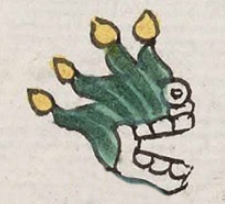malinalli (Mdz39r)
This white, green, and yellow painting of the element malinalli (twisted grass) has been carved from the compound place name glyph Malinaltepec (see below). The twisted grass here is on the top of a white skull. It is four twisted bits of grass, shown in two tones of green with yellow tips.
Stephanie Wood
The skull points to death, and this may be explained because, as shown in our Online Nahuatl Dictionary, nopalli malinalli is a diphrase that stands for blood (owing to the tuna fruit's red juices) and death. The dried malinalli grasses also serve as curative herbs, and they have an association with "the moon, drunkenness, the theluric goddess Cihuacóatl Quilaztli, who is undoubtedly one aspect of witchcraft." [See: Michel Graulich, "Las brujas de las peregrinaciones aztecas," Estudios de Cultural Náhuatl 22 (1992), 87–98, and for this example, see 91.] Malinalli is also a day sign in the tonalpohualli religious divinatory calendar.
c. 1541, but by 1553 at the latest
Jeff Haskett-Wood
hierbas torcidas

malinal(li), tall grass or twisted grass, https://nahuatl.wired-humanities.org/content/malinalli
las hierbas torcidas
Stephanie Wood
Codex Mendoza, folio 39 recto, https://digital.bodleian.ox.ac.uk/objects/2fea788e-2aa2-4f08-b6d9-648c00..., image 88 of 188.
Original manuscript is held by the Bodleian Libraries, University of Oxford, MS. Arch. Selden. A. 1; used here with the UK Creative Commons, “Attribution-NonCommercial-ShareAlike 3.0 License” (CC-BY-NC-SA 3.0)






